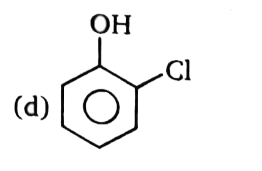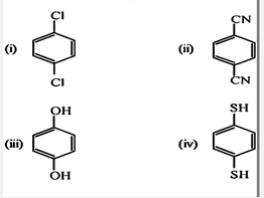In which of the following molecules μ(oberved) is found to be greater than μ (theoretical):
CHCl3



The correct Answer is:D
To solve the problem of determining in which molecule the observed dipole moment (μ_observed) is greater than the theoretical dipole moment (μ_theoretical), we can follow these steps:
Step 1: Understand the Concept of Dipole Moment
Dipole moment (μ) is a measure of the separation of positive and negative charges in a molecule. It is calculated using the formula:
μ=q×r
where q is the charge and r is the distance between the charges.
Step 2: Identify the Molecules
The question implies that there are several molecules to consider. For this solution, let's assume the molecules are CHCl3, H2O, NH3, and HF.
Step 3: Calculate Theoretical Dipole Moments
Theoretical dipole moments can be calculated based on the molecular geometry and the electronegativity differences between the atoms. For example:
- CHCl3 (Chloroform): The dipole moment is expected to be significant due to the presence of chlorine.
- H2O (Water): The dipole moment is high due to the bent shape and the electronegativity of oxygen.
- NH3 (Ammonia): The dipole moment is also significant due to the pyramidal shape.
- HF (Hydrogen Fluoride): The dipole moment is high due to the strong electronegativity of fluorine.
Step 4: Consider Hydrogen Bonding
In some cases, the observed dipole moment can be greater than the theoretical dipole moment due to interactions such as hydrogen bonding. For example, in CHCl3, the hydrogen can form hydrogen bonds with other electronegative atoms (like chlorine), which can lead to an increase in the observed dipole moment.
Step 5: Compare Observed and Theoretical Values
- For CHCl3, the observed dipole moment is greater than the theoretical value due to hydrogen bonding.
- For H2O, NH3, and HF, the observed dipole moments are typically close to the theoretical values, but they do not exceed them significantly.
Conclusion
Based on the analysis, the molecule in which the observed dipole moment (μ_observed) is greater than the theoretical dipole moment (μ_theoretical) is CHCl3 due to the presence of hydrogen bonding.
Final Answer
CHCl3
---
Dipole moment (μ) is a measure of the separation of positive and negative charges in a molecule. It is calculated using the formula:
μ=q×r
where q is the charge and r is the distance between the charges.
The question implies that there are several molecules to consider. For this solution, let's assume the molecules are CHCl3, H2O, NH3, and HF.
Theoretical dipole moments can be calculated based on the molecular geometry and the electronegativity differences between the atoms. For example:
- CHCl3 (Chloroform): The dipole moment is expected to be significant due to the presence of chlorine.
- H2O (Water): The dipole moment is high due to the bent shape and the electronegativity of oxygen.
- NH3 (Ammonia): The dipole moment is also significant due to the pyramidal shape.
- HF (Hydrogen Fluoride): The dipole moment is high due to the strong electronegativity of fluorine.
In some cases, the observed dipole moment can be greater than the theoretical dipole moment due to interactions such as hydrogen bonding. For example, in CHCl3, the hydrogen can form hydrogen bonds with other electronegative atoms (like chlorine), which can lead to an increase in the observed dipole moment.
- For CHCl3, the observed dipole moment is greater than the theoretical value due to hydrogen bonding.
- For H2O, NH3, and HF, the observed dipole moments are typically close to the theoretical values, but they do not exceed them significantly.
Based on the analysis, the molecule in which the observed dipole moment (μ_observed) is greater than the theoretical dipole moment (μ_theoretical) is CHCl3 due to the presence of hydrogen bonding.
CHCl3
Topper's Solved these Questions
- CHEMICAL BONDING (ADVANCED)BOOK - VK JAISWAL ENGLISHCHAPTER - CHEMICAL BONDING (ADVANCED)EXERCISE - Level 3
77 Videos
- CHEMICAL BONDING (ADVANCED)BOOK - VK JAISWAL ENGLISHCHAPTER - CHEMICAL BONDING (ADVANCED)EXERCISE - ONE OR MORE ANSWER IS/ARE CORRECT
78 Videos
- CHEMICAL BONDING (ADVANCED)BOOK - VK JAISWAL ENGLISHCHAPTER - CHEMICAL BONDING (ADVANCED)EXERCISE - SUBJECTIVE PROBLEMS
64 Videos
- CHEMICAL BONDING (BASIC)BOOK - VK JAISWAL ENGLISHCHAPTER - CHEMICAL BONDING (BASIC)EXERCISE - SUBJECTIVE PROBLEMS
54 Videos
Similar Questions
For which of the following molecules μ≠0

View SolutionIn which of the following molecules μexp (observed dipole moment) is found to be greater than μμ (expected dipole moment)?
View SolutionIn which of the following compounds observed bond angle is found to be greater than expected, but not due to back bonding.
View SolutionIn which of the following compounds observed bond angle is found to be greater than expected, but not due to back bonding.
View SolutionOn mixing which of the following solutions, observed boiling point of mixture is higher than theoretical boiling point?
View SolutionOn mixing which of the following solutions, observed boiling point of mixture is higher than theoretical boiling point?
View SolutionFor which of the following molecule significant μ≠0?

View SolutionFor which of the following molecule significant μ≠0 ?

View SolutionFor which of the following molecule significant μ≠0 ?

View SolutionWhich of the following molecule is theoretically not possible ?
View Solution
